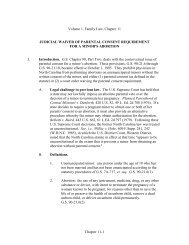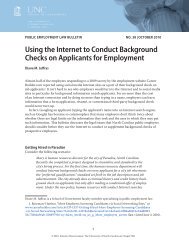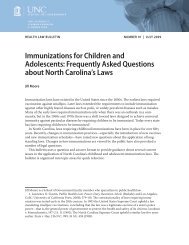Responding to Subpoenas for Health Department Records
Responding to Subpoenas for Health Department Records
Responding to Subpoenas for Health Department Records
- No tags were found...
You also want an ePaper? Increase the reach of your titles
YUMPU automatically turns print PDFs into web optimized ePapers that Google loves.
September 2005 <strong>Health</strong> Law Bulletin No. 82• hearings be<strong>for</strong>e an administrative law judge,administrative agency, or professionallicensing board.In all of these proceedings, the general principlesgoverning subpoenas are the same. There are somedifferences, however, in the procedural details, suchas how a subpoena is issued or how far a person canbe compelled <strong>to</strong> travel.This bulletin concentrates on trials, other in-courthearings, and depositions in state court, theproceedings <strong>for</strong> which health department employeesare most likely <strong>to</strong> receive a subpoena. Rule 45 of theNorth Carolina Rules of Civil Procedure, a set ofprocedures followed in state court, governssubpoenas <strong>for</strong> in-court proceedings (trials andhearings) in both civil and criminal cases. 3 Withminor differences, the rules on subpoenas areessentially the same <strong>for</strong> both types of cases. Rule 45also applies <strong>to</strong> subpoenas <strong>for</strong> depositions, which areused primarily in civil cases. For purposes of thisbulletin, the most important difference between an incourtproceeding, such as a trial, and a deposition isthat at a deposition, no judge is present <strong>to</strong> rule onwhether a subpoena is proper. This difference mayaffect the way you respond <strong>to</strong> a subpoena,particularly one that calls <strong>for</strong> the production ofconfidential in<strong>for</strong>mation (see Question 29, below).Question 3. Does a case have <strong>to</strong> bepending be<strong>for</strong>e a subpoena may be used?Generally, yes. For a party <strong>to</strong> obtain a subpoena,a case must have been initiated and must be pendingin the particular <strong>for</strong>um (civil court, criminal court,administrative agency, and so on). It is generallyimproper <strong>for</strong> a party <strong>to</strong> issue a subpoena when nocase is pending. 43. See G.S. 8-59, -61; G.S. 15A-801, -802.4. See North Carolina Rules of Professional Conduct,Ethics Op. 236 (North Carolina State Bar Ethics Comm.,Jan. 1997) (State Bar finds that it would be improper <strong>for</strong>at<strong>to</strong>rney <strong>to</strong> issue subpoena if no case is pending; opinionalso states that it would be improper <strong>for</strong> at<strong>to</strong>rney <strong>to</strong> issuesubpoena <strong>for</strong> time and place when no proceeding isscheduled, but revised Rule 45 now authorizes such asubpoena in the circumstances described in this bulletin); Inre Superior Court Order, 70 N.C. App. 63, 318 S.E.2d 843(1984) (Rule 45 does not authorize issuance of subpoenabe<strong>for</strong>e action has commenced), rev’d on other grounds, 315N.C. 378, 338 S.E.2d 307 (1986).Be<strong>for</strong>e the 2003 changes <strong>to</strong> Rule 45 of the NorthCarolina Rules of Civil Procedure, there also had <strong>to</strong>be some sort of proceeding scheduled <strong>to</strong> which therecipient was being subpoenaed. The 2003 changesmodified this requirement <strong>for</strong> subpoenas <strong>for</strong>documents (but not subpoenas <strong>to</strong> testify). Forexample, under the <strong>for</strong>mer rule, a party in a civil casewould have <strong>to</strong> schedule a deposition, <strong>to</strong> which theparty would then subpoena the cus<strong>to</strong>dian, even if theparty merely wanted <strong>to</strong> inspect documents in thecus<strong>to</strong>dian’s possession and did not want <strong>to</strong> take anytestimony. Under the revised rule, a party may obtaina subpoena in a pending case directing the recipient<strong>to</strong> produce documents at a designated time and place,such as the issuing party’s office, even though nodeposition or other proceeding is scheduled <strong>for</strong> thattime and place. 5In limited circumstances, a party may obtain asubpoena or its equivalent be<strong>for</strong>e a case is filed. Thus,some North Carolina agencies are authorized <strong>to</strong> issuesubpoenas <strong>for</strong> in<strong>for</strong>mation necessary <strong>to</strong> the agency’sinvestigation. See, e.g., G.S. 15A-298 (authorizing StateBureau of Investigation <strong>to</strong> issue administrative subpoenas<strong>to</strong> compel carriers <strong>to</strong> produce telephone records that arematerial <strong>to</strong> active criminal investigation). In the absence ofa statute authorizing the issuance of a subpoena be<strong>for</strong>e acase is filed, a party must ask a judge <strong>to</strong> issue an order <strong>for</strong>production of records. See, e.g., In re Superior Court Order,315 N.C. 378, 338 S.E.2d 307 (1986) (court has inherentauthority in some circumstances <strong>to</strong> issue order compellingproduction of records).5. The change in Rule 45 authorizing this proceduremay not be readily apparent. It is reflected in the followingitalicized portion of revised Rule 45(a)(2): “A command <strong>to</strong>produce evidence may be joined with a command <strong>to</strong> appearat trial or hearing or at a deposition, or any subpoena maybe issued separately.” See Bill Analysis, S.L. 2003-276,prepared by Trina Griffin, North Carolina GeneralAssembly Research Division (June 27, 2003) (sointerpreting quoted language); Memorandum <strong>to</strong> CourtOfficials Re: S.L. 2003-276, prepared by Pamela WeaverBest, Administrative Office of the Courts Division of Legal& Legislative Services (Sept. 29, 2003) (so interpretingquoted language). These memos are available from theauthors. The revised language is comparable <strong>to</strong> Rule45(a)(1) of the Federal Rules of Civil Procedure, which hasauthorized a similar procedure in federal cases. See 9JAMES WM. MOORE ET AL., MOORE’S FEDERAL PRACTICE §45.02, at 16–17 (3d ed. 2005).3













